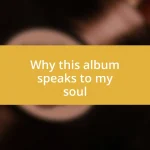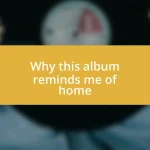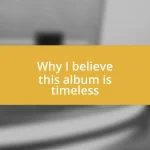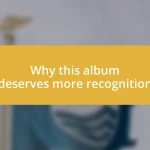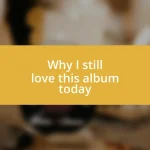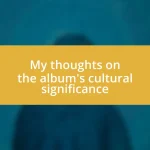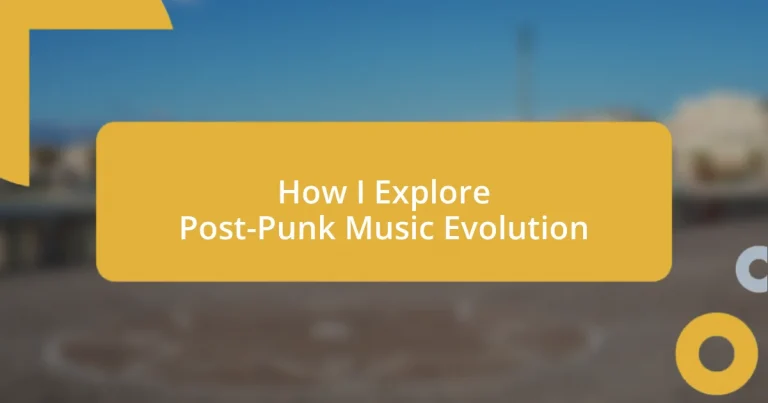Key takeaways:
- Post-punk music emerged in the late 1970s as a response to punk, featuring innovative sounds and emotional depth, shaping a cultural movement focused on individuality and societal reflection.
- Key characteristics of post-punk include experimentalism, atmospheric production, melancholic melodies, unconventional song structures, and prominent bass lines that create a rich emotional landscape.
- Influential bands such as Bauhaus, Wire, and Talking Heads significantly shaped the genre’s evolution, blending various musical styles and themes, while encouraging critical exploration of societal issues through art.
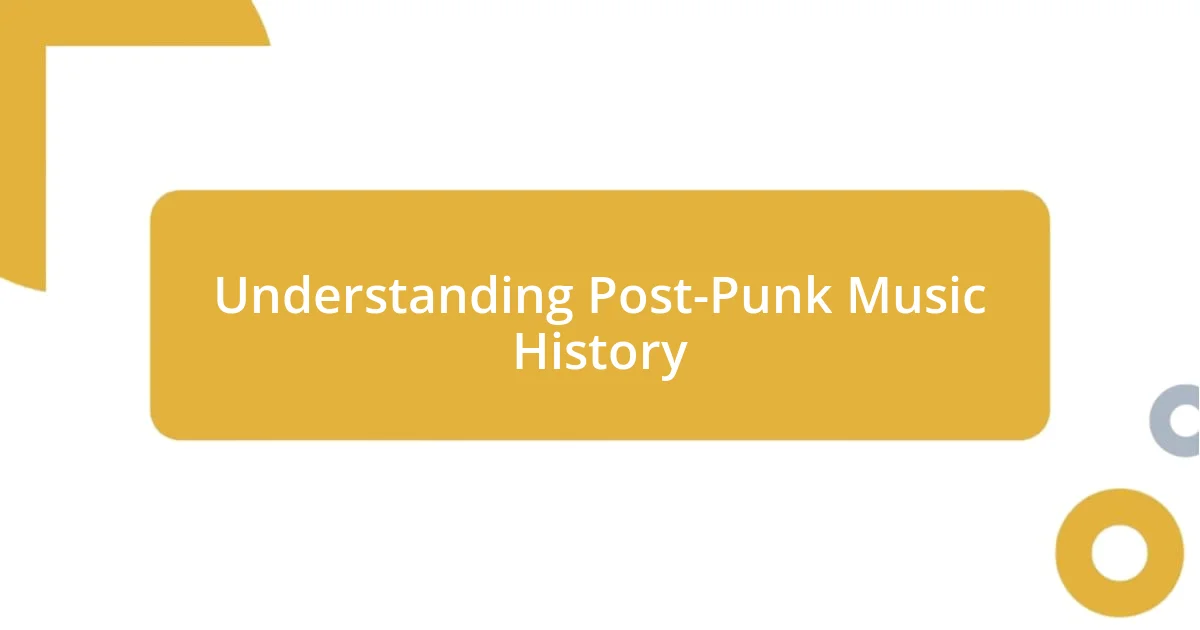
Understanding Post-Punk Music History
Post-punk music emerged in the late 1970s, a response to the raw energy of punk yet craving a more avant-garde edge. I remember the first time I stumbled upon a band like Joy Division; it felt like diving into an ocean of sound that was both haunting and exhilarating. What was it about their dark melodies that resonated so deeply with my own emotions?
As I explored the genre further, I noticed how bands used innovative techniques to shape their sound. The incorporation of electronic elements and unconventional instruments created a diverse sonic landscape. Isn’t it fascinating how artists like The Cure and Talking Heads could craft music that seemed to capture the complexities of human experience? Each listen showed me something new—an unexpected rhythm, a poignant lyric that echoed my own feelings.
Post-punk wasn’t just about the music; it was a cultural movement reflecting societal changes. It thrived on individuality and self-expression, echoing my own journey of finding my voice. I often wonder how those artists, grappling with their own demons, poured their struggles into their art. Could their vulnerability be what continues to draw me back to their music, time and again?
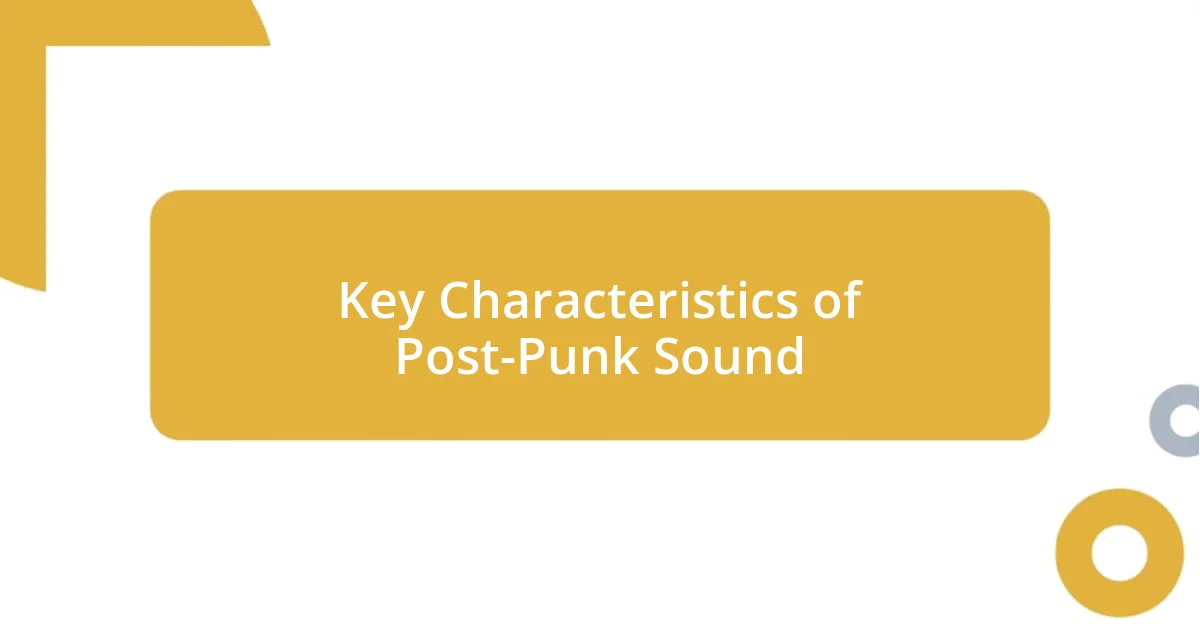
Key Characteristics of Post-Punk Sound
One of the key characteristics of the post-punk sound lies in its distinct blend of musical styles. When I first listened to bands like Siouxsie and the Banshees, I was struck by how they mixed punk’s intensity with jazz and dub influences. This fusion created a soundscape that was both intricate and emotionally charged, reminding me of the beauty in chaos.
Here are some defining features of post-punk music:
- Experimentalism: Artists frequently pushed boundaries, incorporating elements from genres like electronic, reggae, and world music.
- Atmospheric Production: The production often focused on creating mood, using reverb and echo to build an immersive sonic environment.
- Melancholic Melodies: Many tracks showcase haunting melodies that evoke feelings of introspection and nostalgia, much like the songs I’ve turned to during reflective moments.
- Unconventional Song Structures: Post-punk often eschewed traditional verse-chorus patterns, opting instead for a more fluid approach that matches the lyrical themes of disillusionment and alienation.
- Prominent Bass Lines: The bass guitar takes center stage in many songs, driving the rhythm and adding depth, which always leaves me tapping my foot involuntarily.
Listening to these traits unfold in the music adds an extra layer of connection for me. Each element feels like a brushstroke in a wider painting, inviting listeners to dive into the emotional depths it represents.
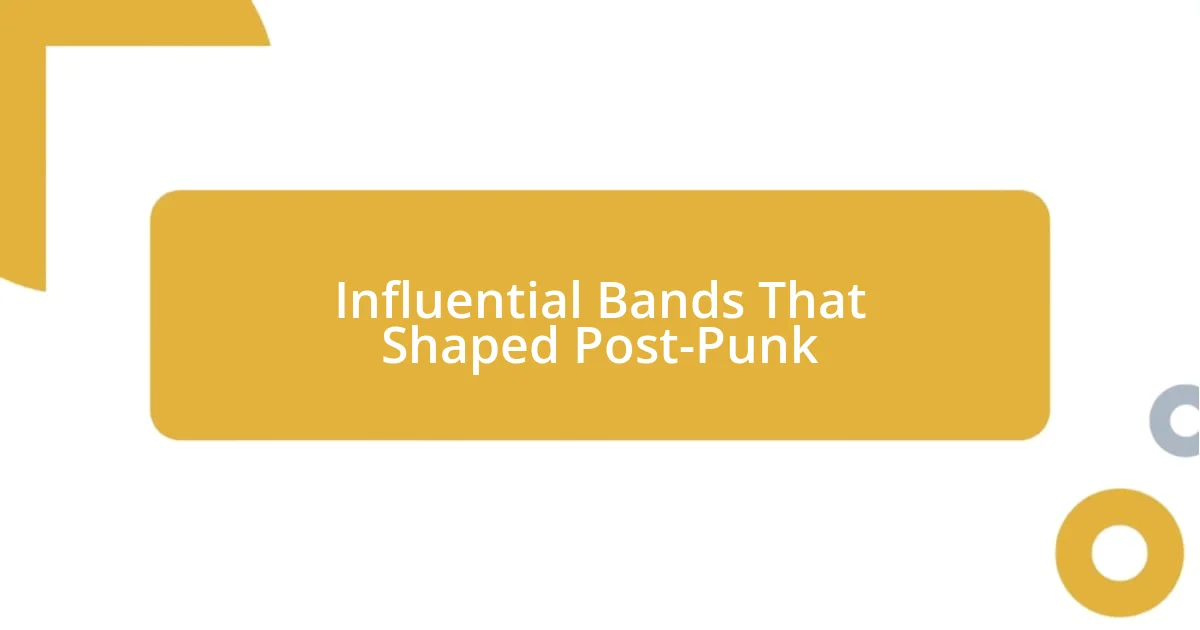
Influential Bands That Shaped Post-Punk
As I delve deeper into the realm of post-punk, it’s impossible to overlook the crucial role of bands like Bauhaus and their iconic track “Bela Lugosi’s Dead.” This seminal song famously fused gothic influences with a punk ethos, creating a sound that’s still resonant today. I recall when I first heard it, the eerie ambiance wrapped around me like a fog, illustrating how effectively they channeled horror themes through their music.
Another band that profoundly shaped post-punk is Wire. With their minimalist style and conceptual songwriting, they influenced countless musicians. I remember listening to “Pink Flag” for the first time; its raw energy and experimental spirit left me exhilarated. It was as though they were screaming for innovation in a world that often felt stagnant.
Let’s not forget Talking Heads, who brought an art-pop sensibility to the genre. Their rhythmically complex yet accessible tracks compelled me to dance, paralleling my own journey of embracing creativity. The song “Once in a Lifetime” spoke to my reflections on identity and time, echoing that familiar tension between the mundane and the extraordinary.
| Band | Influence on Post-Punk |
|---|---|
| Bauhaus | Integrated gothic and punk elements, paving the way for dark wave music. |
| Wire | Introduced minimalist and conceptual approaches, influencing the art-punk movement. |
| Talking Heads | Blended art-rock with world music, expanding the genre’s sonic diversity. |
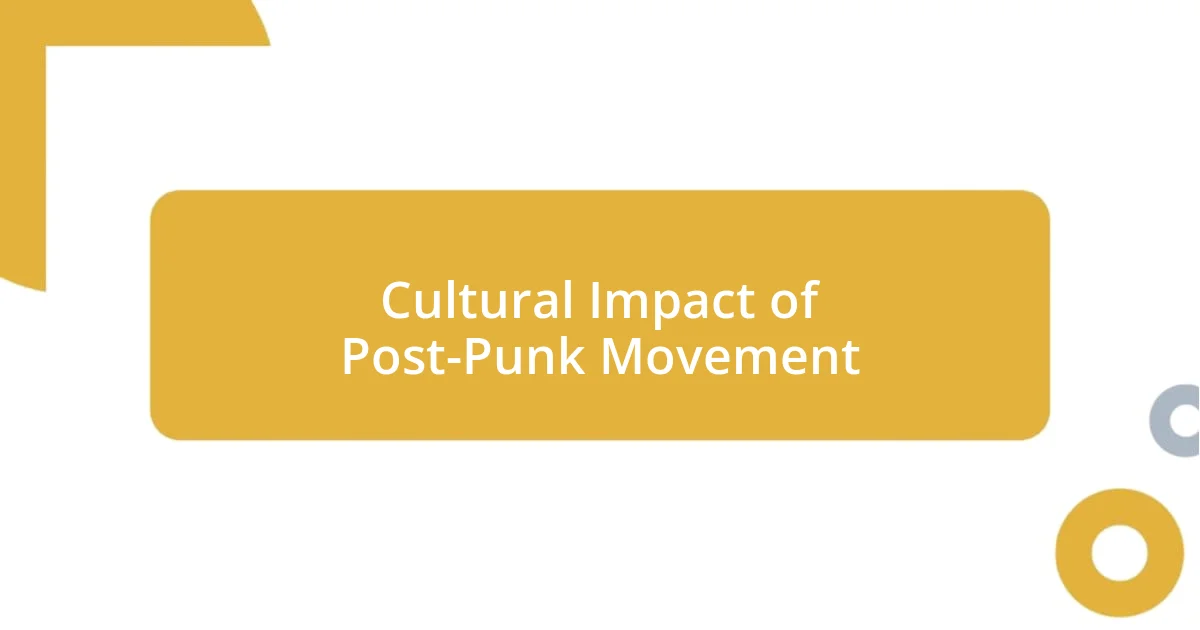
Cultural Impact of Post-Punk Movement
The cultural impact of the post-punk movement is nothing short of profound. I often find myself reflecting on how this genre emerged in the late ’70s and early ’80s as a response to the frustrations bred by its punk predecessor. It invited artists and fans alike to explore deeper emotional landscapes, urging us to confront societal issues through art. Doesn’t it feel liberating when music encourages us to think critically about the world around us?
Personally, discovering the post-punk ethos was eye-opening. It was a movement that rejected the mainstream while simultaneously influencing fashion, visual art, and even literature. At art galleries, I’ve felt the ghost of post-punk as artists incorporated its raw aesthetics into their work, creating dialogues that felt refreshingly honest and unpolished. This blending of mediums allows me to appreciate post-punk not just as music but as a cultural force that challenges norms and inspires creativity across various fields.
I remember attending a small underground venue where a local band paid homage to the post-punk sound. The energy in the room was electric, and as I swayed to their haunting melodies, I sensed a collective understanding among the audience. We were all there, grappling with themes of alienation and existential dread, yet united through the cathartic release this music provided. Isn’t it interesting how a sound can create a safe space to wrestle with our innermost feelings while simultaneously fostering connection?
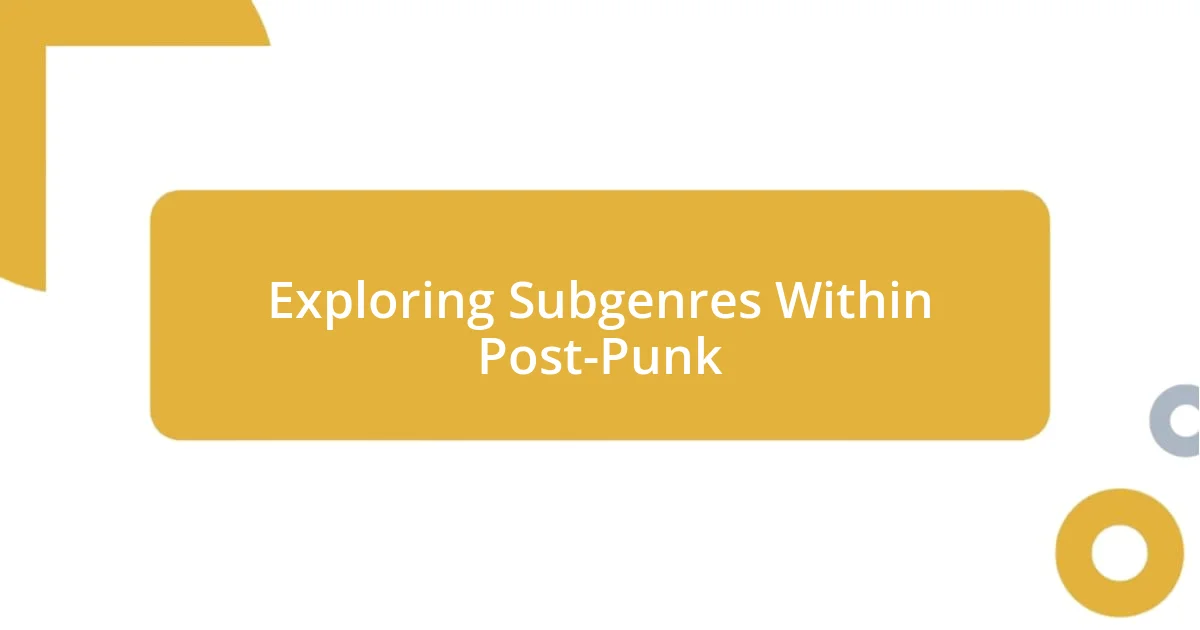
Exploring Subgenres Within Post-Punk
As I dive into the world of post-punk, I find it fascinating how various subgenres emerge, each with its distinct flavor. For instance, take the ethereal soundscape of dream pop, where bands like Cocteau Twins create lush, haunting melodies that take you to another realm. I recall listening to “Heaven or Las Vegas” for the first time; it felt like floating through a dream, enveloped by the enchanting vocals and shimmering guitars.
Then there’s the industrial offshoot, where artists like Nine Inch Nails melded gritty, mechanical sounds with raw, emotional lyrics. I’ll never forget my first encounter with “Head Like a Hole”—it was like a jolt of energy coursing through my veins, awakening a sense of rebellion within me. The blend of harsh instrumentation and powerful themes made me ponder how our environment shapes our emotional responses.
And who could overlook the influence of post-hardcore? Bands like Fugazi brought intensity and complexity, pushing the boundaries of traditional punk. When I attended one of their shows, the energy was palpable; I felt a release as the crowd surged, driven by the raw power of their sound. Isn’t it remarkable how a genre can splinter into so many unique expressions, each resonating differently with listeners? From gothic tones to slam poetry, each subgenre invites us to explore a distinct aspect of the human experience.
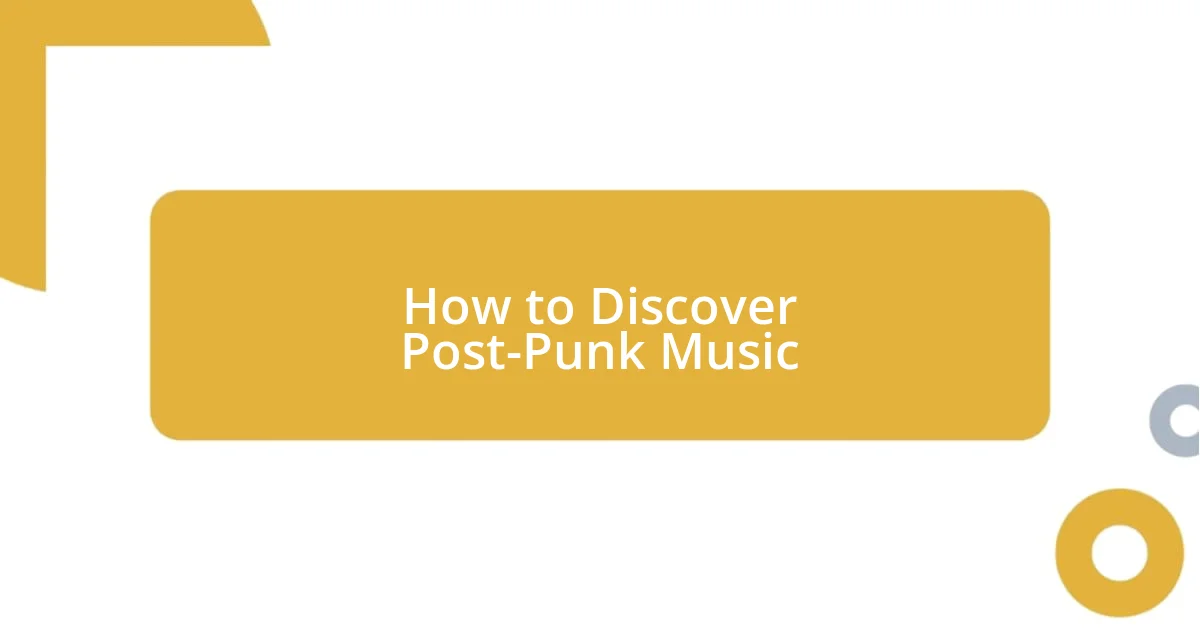
How to Discover Post-Punk Music
To discover post-punk music effectively, I often start by diving into curated playlists on streaming services. Playlists labeled “Post-Punk Essentials” or “Underground Classics” serve as fantastic entry points for newcomers. I vividly remember stumbling upon one such playlist and being captivated by tracks like Joy Division’s “Transmission,” which was unlike anything I had heard before; it struck a chord deep within me.
Exploring music documentaries and films can also enhance your understanding of this genre’s roots and influence. I once watched a documentary that dissected the post-punk movement, unraveling stories of iconic bands and their motivations. This immersive experience helped me connect the dots between music and culture in a way that mere listening couldn’t; it sparked my curiosity to explore lesser-known bands and hidden gems from that era.
Another effective approach is attending live shows featuring post-punk-inspired bands. I remember when I discovered a local act who drew heavily from the post-punk aesthetic; the moment they played their first song, it felt as though I was transported back to the late ’70s. The atmosphere was thick with anticipation, and it struck me how live performances can capture the raw essence of post-punk, allowing me to experience its energy and emotion firsthand, just like in the vibrant underground scenes of the past. Isn’t that the magic of music—how it bridges time and connects us through shared experiences?
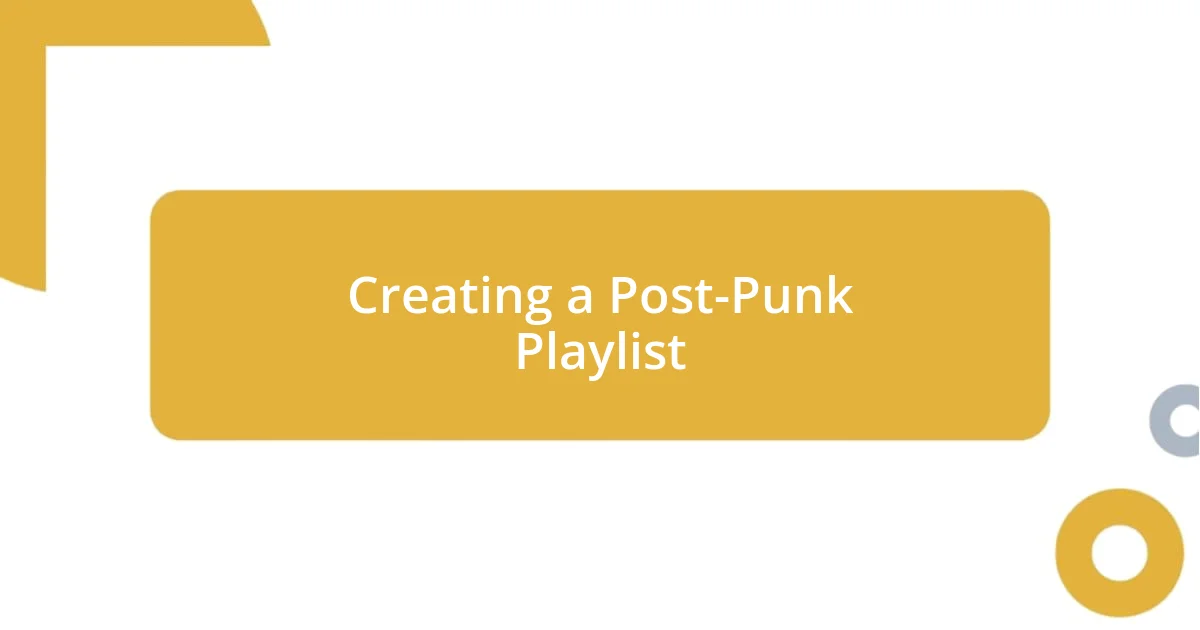
Creating a Post-Punk Playlist
Creating a post-punk playlist can be an exhilarating process, reflecting not just the music but also personal memories and feelings. I often start by selecting tracks that have deeply moved me; for instance, I can never leave out The Cure’s “A Night Like This.” The way those jangly guitars blend with the haunting lyrics evokes a sense of nostalgia and yearning that I cherish. Have you ever noticed how certain songs create emotional anchors in our lives?
As I build my playlist, I pay close attention to the flow of the tracks. It’s essential to weave together different tempos and moods to create a cohesive listening experience. I find that starting with something upbeat like “Psycho Killer” by Talking Heads, then transitioning into the darker melodies of Bauhaus really hones the listening journey. This intentional curation transforms the playlist into more than just a collection; it becomes a narrative. Isn’t it interesting how these sonic journeys can mirror our own experiences, leading us through ups and downs?
I also make a point to include both well-known anthems and hidden gems. Last week, I stumbled upon a lesser-known track by Siouxsie and the Banshees that felt raw and unfiltered, reminding me of the powerful emotion that first drew me to post-punk. Incorporating this balance ensures that the playlist remains engaging and offers a fresh perspective, which is essential for any genre exploration. How often do we find joy in unexpected discoveries, like a long-lost friend?
